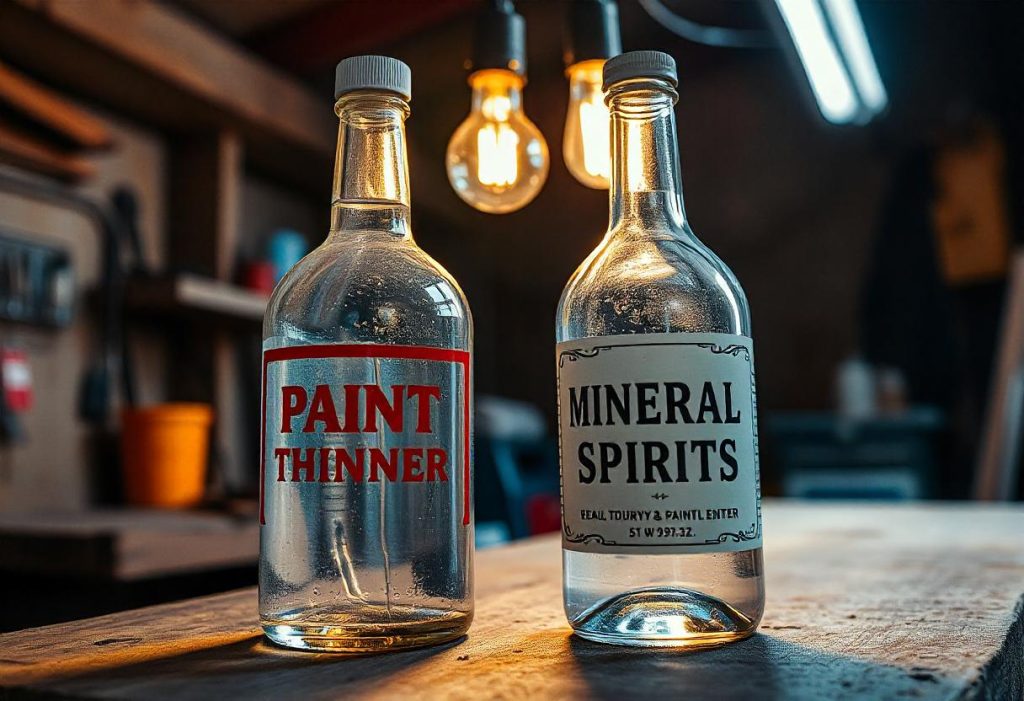Paint thinner and mineral spirits are common solvents used in painting projects, but many people wonder if they are the same. Although they are similar, there are key differences in their composition, effectiveness, and applications.

In this comprehensive guide, we will break down the differences, uses, and safety tips for paint thinner and mineral spirits, helping you choose the right one for your next project.
Contents
- What Are Paint Thinner and Mineral Spirits?
- Are Paint Thinner and Mineral Spirits the Same?
- Common Uses of Paint Thinner vs. Mineral Spirits
- When to Use Paint Thinner or Mineral Spirits
- Can You Substitute Paint Thinner for Mineral Spirits?
- Safety Tips When Using Paint Thinner or Mineral Spirits
- Environmental Impact: Paint Thinner vs. Mineral Spirits
- FAQs About Paint Thinner and Mineral Spirits
- Conclusion
What Are Paint Thinner and Mineral Spirits?
What Is Paint Thinner?
Paint thinner is a generic term for solvents used to thin oil-based paints and clean painting tools. It can be made from various petroleum-based solvents, such as mineral spirits, naphtha, turpentine, or acetone.
- Main use: Thinning oil-based paint and cleaning brushes.
- Composition: A mixture of different solvents, which may vary by brand.
- Odor: Strong and often unpleasant.
- Price: More affordable than mineral spirits.
What Are Mineral Spirits?
Mineral spirits, also known as white spirits, are a refined petroleum-based solvent used mainly for thinning oil-based paints and cleaning brushes.
- Main use: Thinning oil-based paint, cleaning brushes, and degreasing surfaces.
- Composition: A single, highly refined solvent.
- Odor: Less pungent and more tolerable than paint thinner.
- Price: Slightly more expensive than paint thinner.
Are Paint Thinner and Mineral Spirits the Same?
No, paint thinner and mineral spirits are not the same, although they are closely related.
Key Differences:
- Composition:
- Paint thinner: A mixture of solvents (including mineral spirits).
- Mineral spirits: A pure, refined petroleum distillate.
- Odor and Fumes:
- Paint thinner: Stronger odor, more fumes.
- Mineral spirits: Milder odor, less fumes.
- Effectiveness:
- Paint thinner: Effective for thinning paint but may leave residue.
- Mineral spirits: More refined, better for cleaning without residue.
- Price:
- Paint thinner: Cheaper.
- Mineral spirits: Slightly more expensive but more effective.
Common Uses of Paint Thinner vs. Mineral Spirits
Uses of Paint Thinner
- Thinning oil-based paints and varnishes: Ideal for large-scale projects.
- Cleaning brushes and rollers: Removes dried oil paint from tools.
- Removing paint from surfaces: Helps strip paint from metal and wood.
- Degreasing metal parts: Effective for cleaning machinery and tools.
Uses of Mineral Spirits
- Thinning oil-based paints and stains: Perfect for fine detail work.
- Cleaning paintbrushes: Preserves brush bristles without harsh residue.
- Degreasing surfaces: Cleans surfaces before painting or staining.
- Furniture restoration: Gently removes wax and grime from wood.
When to Use Paint Thinner or Mineral Spirits
Use Paint Thinner If:
- You are working on large, rough surfaces (e.g., walls, fences, outdoor furniture).
- You need an affordable option for thinning paint.
- You are removing dried paint from tools or surfaces.
Use Mineral Spirits If:
- You are working on detailed projects (e.g., furniture, cabinets, art pieces).
- You need a low-odor, low-toxicity option.
- You are cleaning high-quality paintbrushes and want to extend their life.
Can You Substitute Paint Thinner for Mineral Spirits?
Yes, but it depends on your project.
- For Paint Thinning: Mineral spirits are a better choice because they are purer and leave no residue.
- For Cleaning Brushes: Either works, but mineral spirits are gentler.
- For Degreasing: Both work well, but mineral spirits evaporate more slowly, allowing better penetration.
Safety Tips When Using Paint Thinner or Mineral Spirits
- Work in a well-ventilated area: Both solvents emit fumes that can be harmful if inhaled.
- Wear gloves and protective eyewear: Avoid skin and eye contact.
- Store properly: Keep containers tightly closed and away from heat sources.
- Dispose of properly: Follow local regulations for hazardous waste disposal.
Environmental Impact: Paint Thinner vs. Mineral Spirits
- Paint Thinner: More likely to contain harsh chemicals and additives.
- Mineral Spirits: Purified and less harmful, especially the odorless or low-VOC (volatile organic compounds) versions.
Eco-Friendly Alternatives:
- Citrus-based solvents: Natural and biodegradable.
- Soy-based solvents: Effective for cleaning and paint removal.
FAQs About Paint Thinner and Mineral Spirits
Can I Use Mineral Spirits to Thin Water-Based Paints?
No, mineral spirits are for oil-based paints only. For water-based paints, use water or a water-based thinning agent.
Are Odorless Mineral Spirits Safer?
Odorless mineral spirits have fewer fumes but are still toxic. Always use them in a ventilated space.
Can I Mix Thinner and Mineral Spirits?
Yes, but it’s unnecessary. Mineral spirits are a type of paint thinner, so choose based on your project’s needs.
How Should I Dispose of Thinner or Mineral Spirits?
- Do not pour down the drain.
- Let used solvent evaporate in a metal container outdoors or take it to a hazardous waste facility.
Conclusion
Paint thinner and mineral spirits may seem interchangeable, but their differences can impact your project’s outcome.
- Use paint thinner for large-scale, rough work where cost-effectiveness matters.
- Use mineral spirits for fine work, brush care, and a cleaner finish with less odor.
Both are valuable tools for DIYers and professionals, but understanding their strengths will help you achieve the best results while staying safe and eco-conscious.
